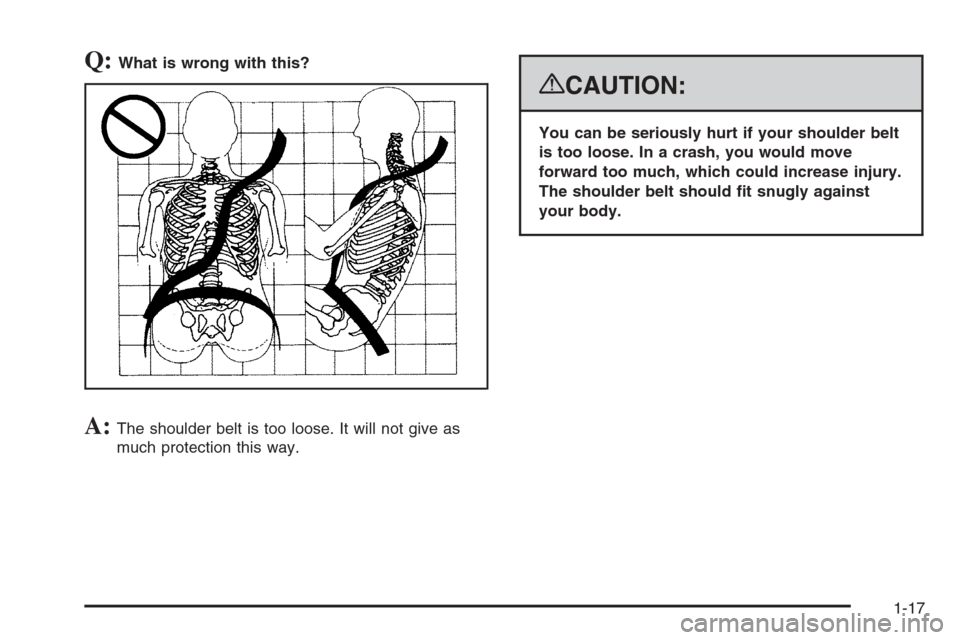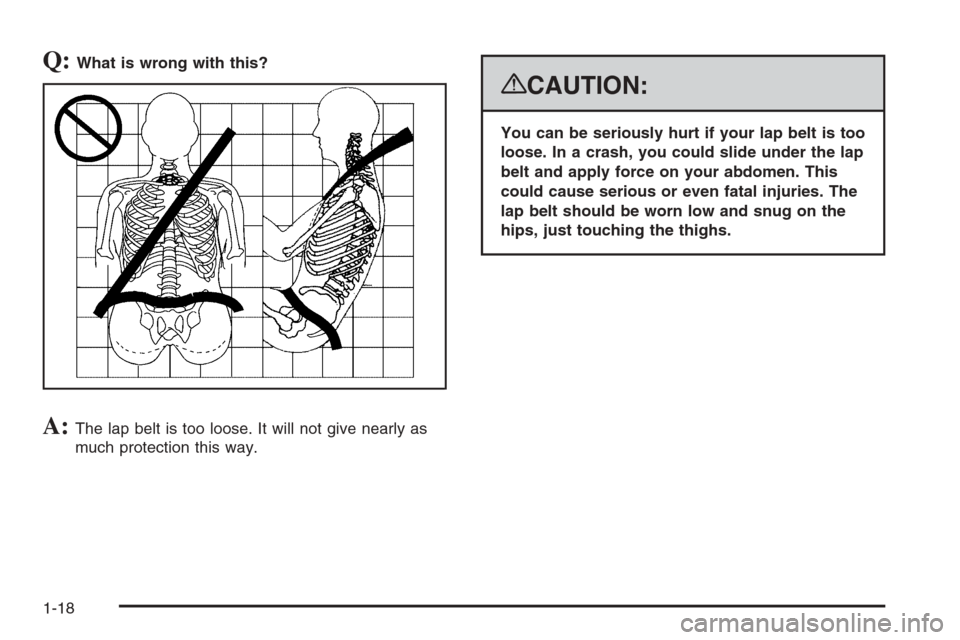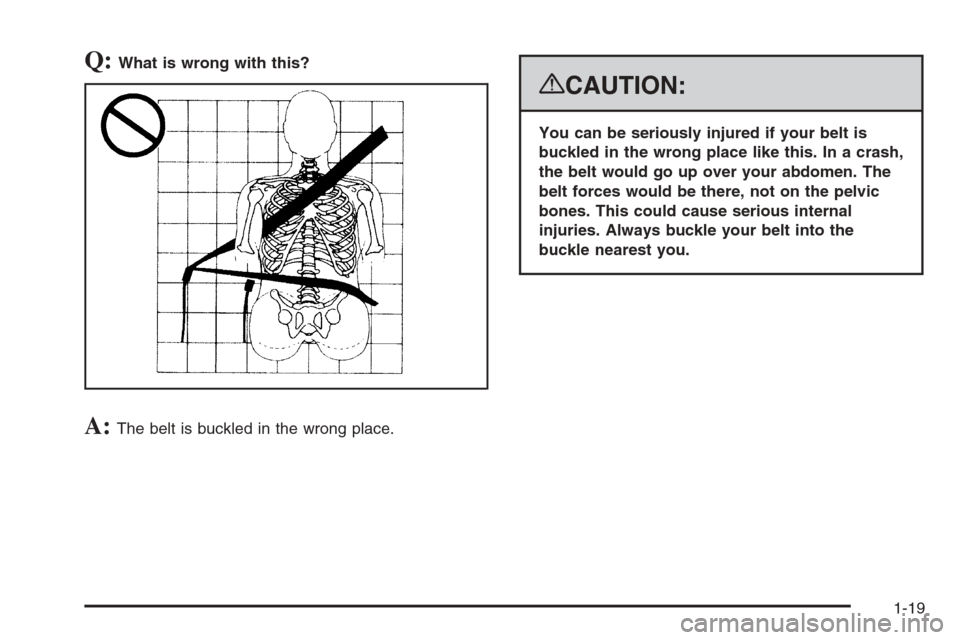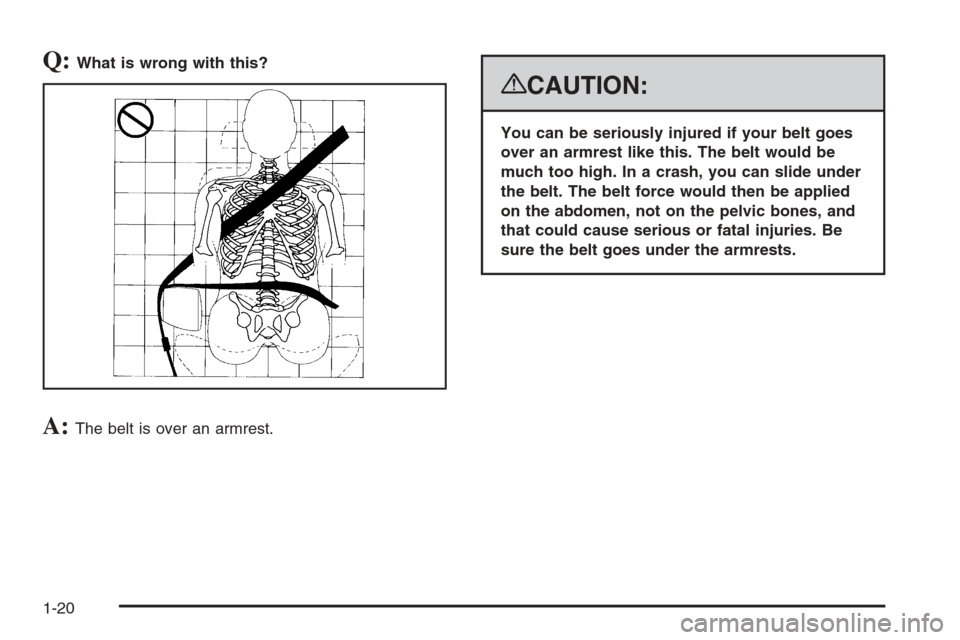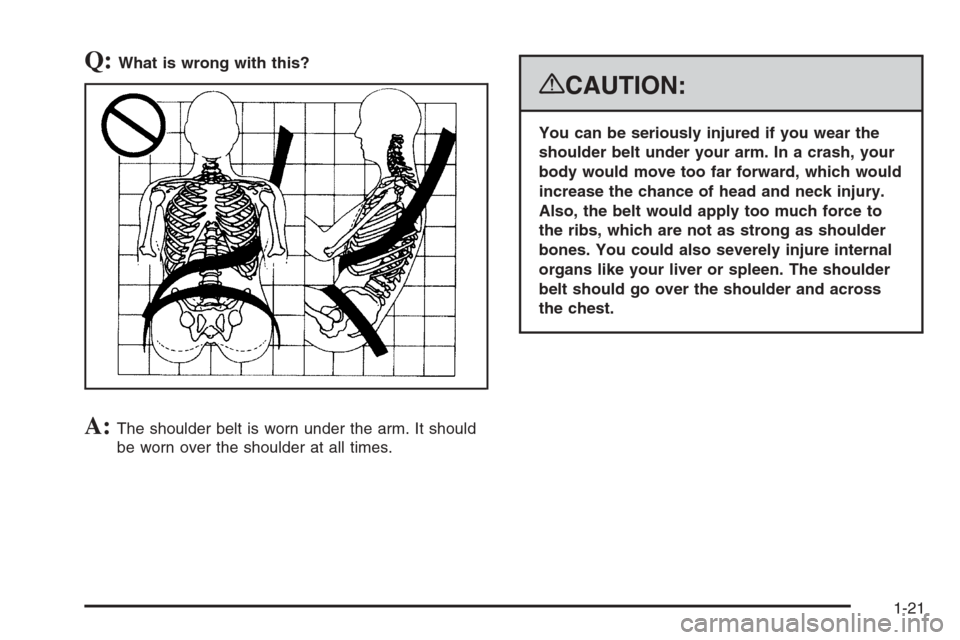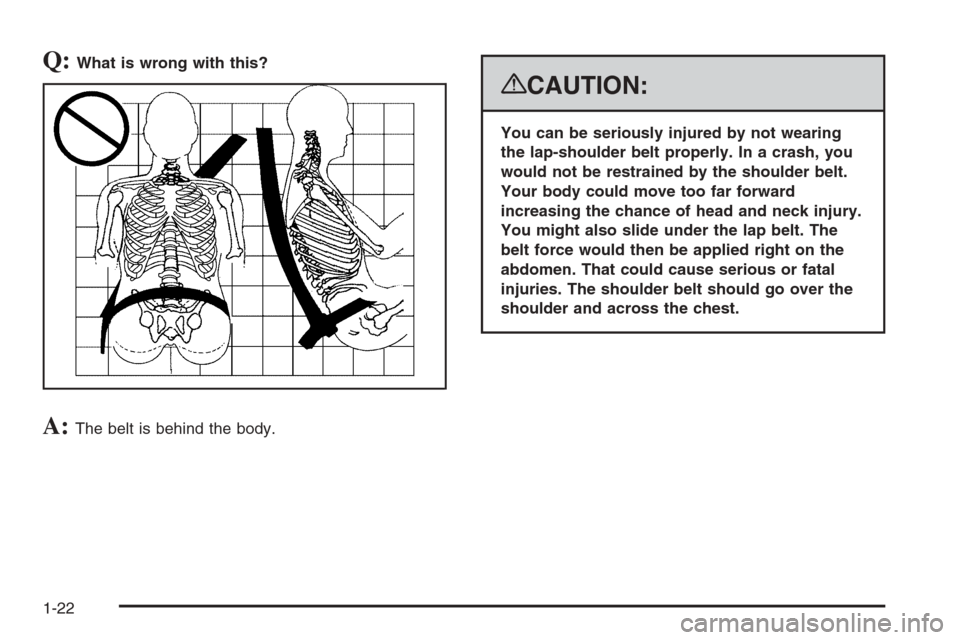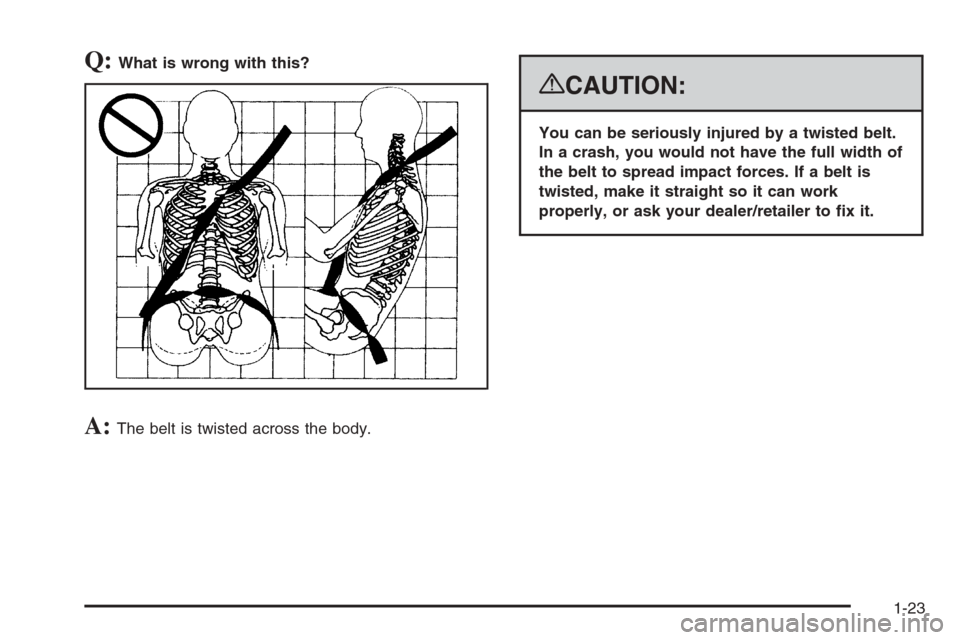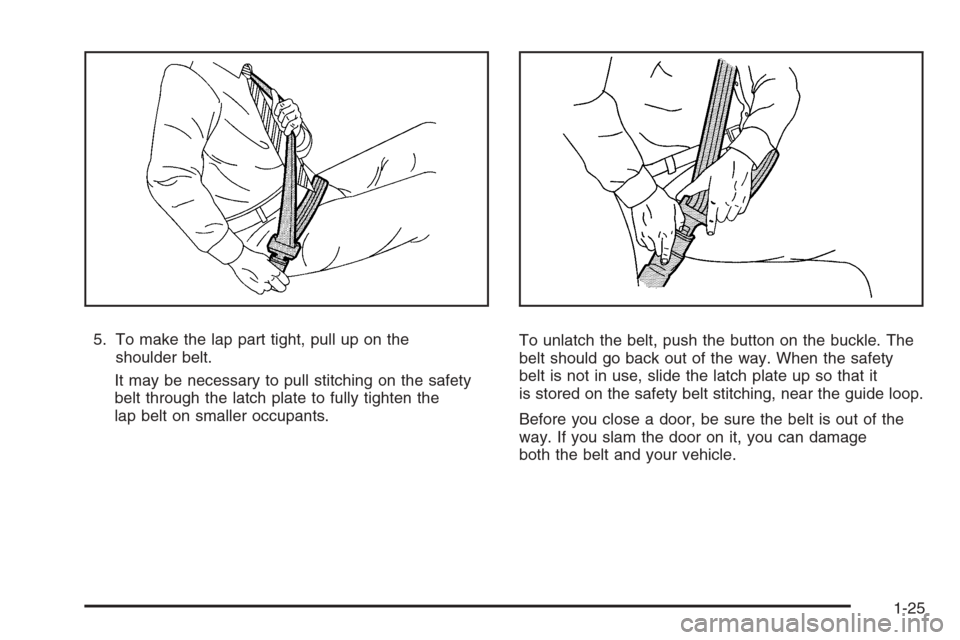CADILLAC DTS 2008 1.G Owner's Manual
DTS 2008 1.G
CADILLAC
CADILLAC
https://www.carmanualsonline.info/img/23/7892/w960_7892-0.png
CADILLAC DTS 2008 1.G Owner's Manual
Trending: spare tire location, power steering fluid, air filter, key fob, start stop button, stop start, oil dipstick
Page 21 of 454
Q:What is wrong with this?
A:The shoulder belt is too loose. It will not give as
much protection this way.
{CAUTION:
You can be seriously hurt if your shoulder belt
is too loose. In a crash, you would move
forward too much, which could increase injury.
The shoulder belt should �t snugly against
your body.
1-17
Page 22 of 454
Q:What is wrong with this?
A:The lap belt is too loose. It will not give nearly as
much protection this way.
{CAUTION:
You can be seriously hurt if your lap belt is too
loose. In a crash, you could slide under the lap
belt and apply force on your abdomen. This
could cause serious or even fatal injuries. The
lap belt should be worn low and snug on the
hips, just touching the thighs.
1-18
Page 23 of 454
Q:What is wrong with this?
A:The belt is buckled in the wrong place.
{CAUTION:
You can be seriously injured if your belt is
buckled in the wrong place like this. In a crash,
the belt would go up over your abdomen. The
belt forces would be there, not on the pelvic
bones. This could cause serious internal
injuries. Always buckle your belt into the
buckle nearest you.
1-19
Page 24 of 454
Q:What is wrong with this?
A:The belt is over an armrest.
{CAUTION:
You can be seriously injured if your belt goes
over an armrest like this. The belt would be
much too high. In a crash, you can slide under
the belt. The belt force would then be applied
on the abdomen, not on the pelvic bones, and
that could cause serious or fatal injuries. Be
sure the belt goes under the armrests.
1-20
Page 25 of 454
Q:What is wrong with this?
A:The shoulder belt is worn under the arm. It should
be worn over the shoulder at all times.
{CAUTION:
You can be seriously injured if you wear the
shoulder belt under your arm. In a crash, your
body would move too far forward, which would
increase the chance of head and neck injury.
Also, the belt would apply too much force to
the ribs, which are not as strong as shoulder
bones. You could also severely injure internal
organs like your liver or spleen. The shoulder
belt should go over the shoulder and across
the chest.
1-21
Page 26 of 454
Q:What is wrong with this?
A:The belt is behind the body.
{CAUTION:
You can be seriously injured by not wearing
the lap-shoulder belt properly. In a crash, you
would not be restrained by the shoulder belt.
Your body could move too far forward
increasing the chance of head and neck injury.
You might also slide under the lap belt. The
belt force would then be applied right on the
abdomen. That could cause serious or fatal
injuries. The shoulder belt should go over the
shoulder and across the chest.
1-22
Page 27 of 454
Q:What is wrong with this?
A:The belt is twisted across the body.
{CAUTION:
You can be seriously injured by a twisted belt.
In a crash, you would not have the full width of
the belt to spread impact forces. If a belt is
twisted, make it straight so it can work
properly, or ask your dealer/retailer to �x it.
1-23
Page 28 of 454
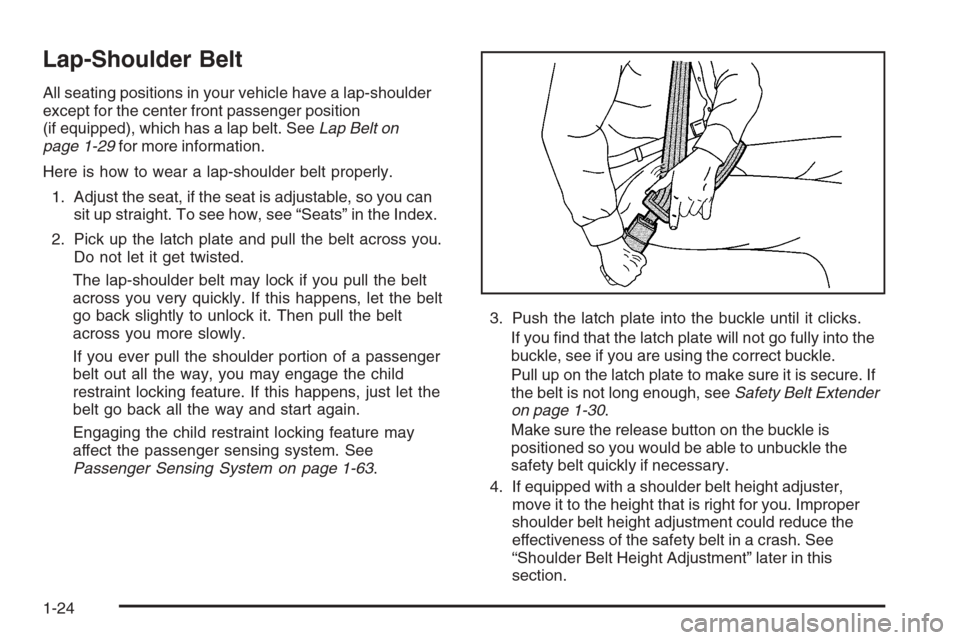
Lap-Shoulder Belt
All seating positions in your vehicle have a lap-shoulder
except for the center front passenger position
(if equipped), which has a lap belt. SeeLap Belt on
page 1-29for more information.
Here is how to wear a lap-shoulder belt properly.
1. Adjust the seat, if the seat is adjustable, so you can
sit up straight. To see how, see “Seats” in the Index.
2. Pick up the latch plate and pull the belt across you.
Do not let it get twisted.
The lap-shoulder belt may lock if you pull the belt
across you very quickly. If this happens, let the belt
go back slightly to unlock it. Then pull the belt
across you more slowly.
If you ever pull the shoulder portion of a passenger
belt out all the way, you may engage the child
restraint locking feature. If this happens, just let the
belt go back all the way and start again.
Engaging the child restraint locking feature may
affect the passenger sensing system. See
Passenger Sensing System on page 1-63.3. Push the latch plate into the buckle until it clicks.
If you �nd that the latch plate will not go fully into the
buckle, see if you are using the correct buckle.
Pull up on the latch plate to make sure it is secure. If
the belt is not long enough, seeSafety Belt Extender
on page 1-30.
Make sure the release button on the buckle is
positioned so you would be able to unbuckle the
safety belt quickly if necessary.
4. If equipped with a shoulder belt height adjuster,
move it to the height that is right for you. Improper
shoulder belt height adjustment could reduce the
effectiveness of the safety belt in a crash. See
“Shoulder Belt Height Adjustment” later in this
section.
1-24
Page 29 of 454
5. To make the lap part tight, pull up on the
shoulder belt.
It may be necessary to pull stitching on the safety
belt through the latch plate to fully tighten the
lap belt on smaller occupants.To unlatch the belt, push the button on the buckle. The
belt should go back out of the way. When the safety
belt is not in use, slide the latch plate up so that it
is stored on the safety belt stitching, near the guide loop.
Before you close a door, be sure the belt is out of the
way. If you slam the door on it, you can damage
both the belt and your vehicle.
1-25
Page 30 of 454
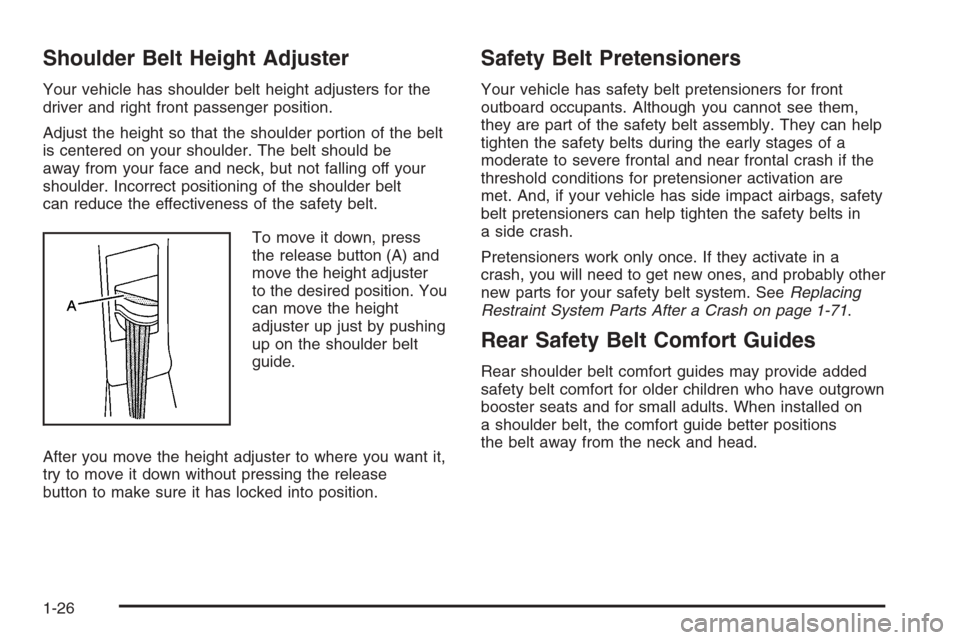
Shoulder Belt Height Adjuster
Your vehicle has shoulder belt height adjusters for the
driver and right front passenger position.
Adjust the height so that the shoulder portion of the belt
is centered on your shoulder. The belt should be
away from your face and neck, but not falling off your
shoulder. Incorrect positioning of the shoulder belt
can reduce the effectiveness of the safety belt.
To move it down, press
the release button (A) and
move the height adjuster
to the desired position. You
can move the height
adjuster up just by pushing
up on the shoulder belt
guide.
After you move the height adjuster to where you want it,
try to move it down without pressing the release
button to make sure it has locked into position.
Safety Belt Pretensioners
Your vehicle has safety belt pretensioners for front
outboard occupants. Although you cannot see them,
they are part of the safety belt assembly. They can help
tighten the safety belts during the early stages of a
moderate to severe frontal and near frontal crash if the
threshold conditions for pretensioner activation are
met. And, if your vehicle has side impact airbags, safety
belt pretensioners can help tighten the safety belts in
a side crash.
Pretensioners work only once. If they activate in a
crash, you will need to get new ones, and probably other
new parts for your safety belt system. SeeReplacing
Restraint System Parts After a Crash on page 1-71.
Rear Safety Belt Comfort Guides
Rear shoulder belt comfort guides may provide added
safety belt comfort for older children who have outgrown
booster seats and for small adults. When installed on
a shoulder belt, the comfort guide better positions
the belt away from the neck and head.
1-26
Trending: tires, bulb, jacking, spare tire location, steering wheel adjustment, instrument cluster, language
